DO-IT News April 2001

Volume 9, Number 1
Below are the articles of the DO-IT News April 2001 newsletter. These articles can also be seen all on one page at the Full Newsletter option.
Director's Digressions
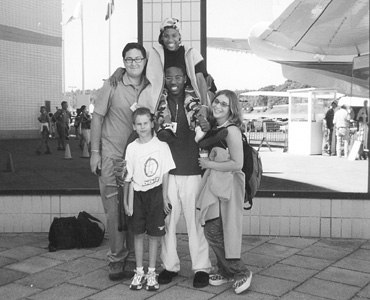
DO-IT began in 1992 as a grant from the National Science Foundation to promote the success of young people with disabilities in science, technology, engineering and mathematics. Once funding for this nationwide experimental project ended, the State funded participation in DO-IT for Washington residents.
For the past three years, the State of Washington has funded participation in the DO-IT Scholars program. Teens with disabilities travel from all around the state to participate in Summer Study programs and other activities. They communicate year-round with mentors via electronic mail. They are all preparing for college and careers and to be leaders of the next generation. Here are some of the cities that they call home:
Aberdeen, Auburn, Bellingham, Bonney Lake, Bothell, Burlington, Cashmere, Chelan, Cheney, Coupeville, Duvall, Edmonds, Federal Way, Goldendale, Grandview, Granite Falls, Grays Harbor, Hoquiam, Kennewick, Kettle Falls, Kirkland, Lind, Lynnwood, McKenna, Moses Lake, Mount Vernon, Olympia, Pasco, Puyallup, Redmond, Rock Island, Rosalia, Sammamish, Seattle, Spokane, Sunnyside, Tacoma, Vancouver, Vashon Island, Wenatchee, Yakima, Yelm.
- From high school to college
- From two-year schools to four-year institutions
- From school to work
We continue to promote their success in high tech fields where people with disabilities have been underrepresented. Educators, service providers, employers, parents, and mentors are important players on the DO-IT team.
After DO-IT Scholars join us for several summers at the University of Washington, they continue to participate as DO-IT Ambassadors by sharing their college and work experiences with new Scholars. This issue of DO-IT News focuses on the experiences of DO-IT Scholars, Ambassadors and Mentors.
The fact that past Scholars stay connected to the DO-IT community and contribute to program efforts, speaks to the important place DO-IT fits into their lives. Keaton, blind since birth, attended his first Summer Study program in 1997. Now he mentors younger Scholars in his role as a DO-IT Ambassador. Keaton says it all as he welcomes our 2001 group of DO-IT Scholars:
Hello and welcome to all the new DO-IT Scholars!
Be prepared for one of the greatest experiences in your lives. DO-IT Summer Study and the program in general are best described in the word of one of my fellow '97 DO-IT Scholars, "DO-IT ROCKS!!!"
Each of you has tremendous potential, and DO-IT can help you actualize it. My advice is to jump in and wholeheartedly take the DO-IT experience for all it is worth. Congratulations, it is good to have you onboard.
DO-IT changed my life. It helped me go from feeling like just another person, to feeling like just another AWESOME person. DO-IT brought me closer to my dreams, to where I could feel them and touch them. It showed me that each one of us can do whatever we set out to accomplish, if we are willing to work hard enough. We can DO-IT!
Boeing Invests in DO-IT
DO-IT received a holiday gift from Boeing. Joyce A. Walters, K-12 Community Investor from Boeing, delivered a check for $25,000 to help support DO-IT efforts. This gift is "in recognition of (DO-IT's) continued dedication to helping students achieve their full potential." State and federal funds and gifts like these keep the DO-IT project alive and well. Thank you, Boeing.
DO-IT Scholar Becomes Rhodes Scholar
The following article about Zachary, DO-IT Scholar of 1996, is reprinted with permission from the Philadelphia Inquirer, December 20, 2000.
Rhodes Scholar's Blindness Gave Him a Will to Succeed
Zachary has ambition, guts and an extraordinary brain. He is a math and computer whiz, loves the theater, and he leaves tomorrow for a second stint teaching English in Ukraine.
He is also blind.
Without sight almost since birth and adopted from a South Korean orphanage when he was 4, Battles, a 21-year-old senior at Pennsylvania State University, has spent his life proving that a lack of sight need not be a deterrent. On Saturday, the latest affirmation came when he was named one of 32 Rhodes scholars, earning one of the most prestigious academic fellowships in the world.
Next summer, he will go to Oxford, England, where he will spend at least two years pursuing a doctorate in numerical analysis. He expects to graduate from Penn State in spring 2001 with three degrees: a bachelor's in math, and a bachelor's and master's in computer science.
And a minor in French.
Taking six to seven courses a semester, he has maintained a near-perfect grade-point average.
"I've always wanted to go to Oxford," said Battles, whose family lives in State College, a few blocks from campus. "This is just one of the ways of getting there. But I didn't focus on aiming for a Rhodes, because they're so difficult to get."
The winners, officially announced Sunday, came from 950 applicants nationwide. Battles learned of his selection Saturday, after being interviewed in New York City by a nine-member Rhodes board.
Three of the 32 scholars are from Pennsylvania, the most from any one state. They are Battles; Seth A. Bodnar of Franklin, who attends the U.S. Military Academy; and Brandon Miller of Mohrsville, a student at Princeton University.
The University of Pennsylvania's Lipika Goyal of Scotch Plains, N.J., and Thomas M. Pallathy of Newark, Del., and the University of Delaware, also were selected.
Applying for the Rhodes was actually an afterthought for Battles, said Mary Gage, who coordinates undergraduate fellowships at Penn State. Battles came to her after the school already had decided on its nominees. She told him he might want to apply next year.
"But I thought about it overnight and told him to try for it," she said. "When you look at what he's done to get there, he has to be looked at as a campus phenomenon."
Battles was adopted by Richard and Barbara Battles, becoming part of a family that eventually would grow to 18 children - 15 of them adopted - who now range in age from 5 to 31.
"We saw right away how bright he was," said Barbara Battles. "I worked with him part of each day, because we wanted to mainstream him into the school district, not send him to a special school. He learned Braille way before he started school."
His academic prowess was evident early on, and he thrived on challenges, his teachers say. After graduating from State College High School in 1997, he entered Penn State's Schreyer Honors College.
"He's been a very dedicated and committed scholar for many years," said Cheryl Achtenberg, the dean of Schreyer. "He has a tremendous power of concentration, so he can pick up different things very quickly. Usually, you only have to show him how to do something once and he has learned it forever."
"And he fends very well for himself. He doesn't lean on people to help him at all. He was well-known in school, well-liked and an inspiration for anyone who's acquainted with him."
Battles said his blindness - it is caused by the rare genetic eye disorder Leber's congenital amaurosis - played a part in his drive to prove nothing could hold him back.
"Every blind individual has a responsibility to show everyone else that they are just as capable of doing things," Battles said. He has designed teaching tools for the blind. Last year, he was part of an international delegation that traveled to Costa Rica to exchange ideas with disabled residents of that country. Besides returning to Ukraine, he plans to take a two-week course in theater in London during his winter break before beginning the spring semester at Penn State.
"I've grown up loving the theater and wanted to expand my horizons," Battles said.
He is not sure whether he eventually will teach or continue with his research. He is sure he wants to continue to work with the disabled. "There are different paths I can take," Battles said. "I'm just willing to help, however and whenever I can."
Summer Study 2000: What Did the Phase I Scholars Do?
DO-IT Phase I Scholars participate in a two-week, live-in summer study session on the University of Washington campus in Seattle. They learn about college life; surf the Internet; interact with peers, staff, and mentors; and have fun. Below, '00 Phase I Scholars share some of their experiences.
Life in the Dorm
by '00 Scholars Susanna and Gretchen
DO-IT provides the opportunity to experience life away from home, living life in college dorm rooms. One of the many differences between home life and college life is that you live with a roommate. A dorm life is always interesting - there are people all around you, bathrooms to compete for, dorm food to experience, sports to challenge, obstacles to overcome. One of the main challenges in college is to keep in touch with family members. In this day and age, we have many options, such as e-mail, and cell phones. The only way to enjoy yourself in college is to make yourself at home. Some ways you can accomplish this are plastering your walls with N*SYNC pictures, bringing your TV, putting up Christmas lights, and hanging lots of pictures.
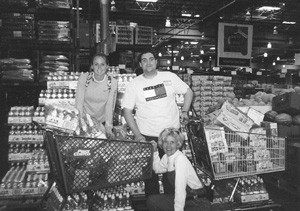
If you keep on friendly terms with everyone, you will do fine in college. The most important thing to remember is that if you respect people's space, time, and sleep, they will respect yours also.
Accessibility of Girls' Restroom in McCarty Hall
by '00 Scholars Corinna and Nora
DO-IT Scholars evaluate the accessibility of facilities and programs and make recommendations to create a more inclusive world. For example, below is an evaluation of the restroom for the girls in the McCarty Hall Summer Study dorm by Corinna, a wheelchair user and Nora, a Scholar who uses a walker.
Corinna-The community restroom on the second floor in McCarty Hall is pretty accessible for people in electric wheelchairs to maneuver in. I think the first time I went to look at it, I was kind of having second thoughts about its accessibility, but then I found out it is perfectly fine. The toilet in the handicap stall has a raised seat. The restroom has an adaptable shower area. And it has sinks you can get to very easily.
Nora-The restroom on McCarty's second floor is very accessible if you use a walker. Even if you have to use a small stall, there are handholds for balance. The sinks are easy to get to and can be leaned against if you need to. The shower area is pretty good, but you have to watch out for the step into the shower. It is fairly high for someone who can't lift a foot very far.
Postscript: McCarty Hall is now in the process of a major renovation. It is expected that input from DO-IT Scholars over the years will make it a model for accessibility.
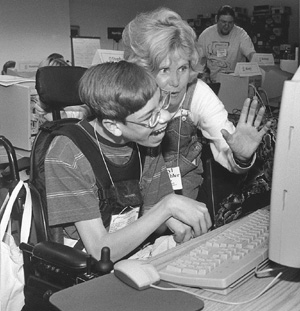
Life in College
by '00 Scholars Jeff and Brian
Preparing to go to college is a time of change, of reorganization, and of new-found independence. If you are not able to adapt, you will surely sink, as opposed to swim. There are many things that must be done to prepare for college. First, tests must be taken. Students must chose between the SAT, ACT, and others, depending on the type of college they wish to attend. Also, the choice must be made as to whether to attend a local, out-of-state, or international university. The matter of moving comes next for some students. Transportation to the college is not much of an issue if the student is planning to live at home. For a college or university that is farther away, though, this must be considered. There are, of course, the orientations, the forms to fill out, and then, dealing with your new roommate.
College is completely different than high school. There are fewer things to study, but students will find themselves spending much, much more time studying. Students will also find that they will have much more time to socialize with their peers, and they will. College allows students to exercise their newly-found freedom and independence that comes both with adulthood and from living away from home.
Meeting New People at Summer Study
by '00 Scholars Jamie and Stephanie
We didn't expect to meet very many people here. There were 19 other Scholars whom we didn't even know, and that was scary. As we got later into the week, we got to know everyone. The other kids were doing the same thing that we were-trying to make new friends. This turned out to be a lot of fun. We got to know each other and it was great.
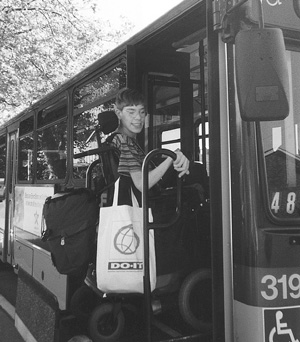
Experience Music Project
by '00 Scholars Ryan and Nathan
Visiting the EMP (Experience Music Project) was an interesting experience. It is a LARGE and overwhelming expanse from the outside. You enter into sky church. There is a place to pick up this little device that looks like a cross between a palm pilot, a suite for laser tag, and your TV remote. They are called MAGS. These are used for listening to information about the band(s) that are pictured in the cases. It is dark; you can hardly see. They feature bands that were either near/from Seattle or had an influence on music at some time. The EMP also has a lot of music artifacts, from Jimi Hendrix's clothes that he wore in some of his concerts, to lyrics to songs that were handwritten by the artist, to guitars donated by artists. Other than the poor lighting and the narrow selection of music, EMP is pretty good over all.
Postscript: DO-IT Scholars created a list of suggestions to make the EMP more accessible to people with a wide range of disabilities; DO-IT staff presented this list to EMP administrators who will report on progress at the next Summer Study.
SKIFORALL
by '00 Scholars Raleigh and Israel
SKIFORALL was very fun. We got to ride on all sorts of fun bikes and just have a blast. They had four-wheelers, two-wheelers, two-seaters, and bikes for people who aren't able to ride a regular bike. Is that cool or what? We all had a blast. The bikes really showed you that no matter what kind of disability you have, you can DO-IT.
Pacific Science Center
by '00 Scholars Deke and Nick
During Summer Study we went to the Pacific Science Center. It was great. We went to the IMAX, Laserium, and a cool robot lab. The only drawback to going on that Saturday is we didn't have enough time. We couldn't get through it all. Oh well, it was still a great experience.
When we went to the IMAX we thought that the dolphin story was very real. Nick said, "You really felt like you were in the water with them." Deke thought that the dolphin story was really realistic and very well done. We were very impressed. The Laserium was great. We both agree that if you have never been to one, it is definitely an experience that you don't want to miss. Nick said that it was cool because you could watch the music and listen all at the same time. Deke liked it because of the laser effects.
The robot thing was great. Deke thought that it was fun interacting with the robots. He got to play tic-tac-toe against the robot and it was fun. Nick liked the entire robot humor. "It was great," he said. He thought it was cool.
Overall we thought it was a great experience. We really enjoyed it. Like we said before, we wish we could have spent more time there.
Burke Museum
by '00 Scholars Andrea and Brooke
We visited the Burke Museum on the University of Washington campus. The museum is focused on the natural history of the Northwest. The Burke Museum is a fine example of an accessible museum that everyone can use. For people with visual impairments, they have objects that you can touch and videos that you can hear along with bigger text you can read easily. For people with hearing impairments, there are captions for the videos. There are also ramps and bigger buttons for people with physical impairments. For people with learning disabilities, the layouts of the rooms are very similar to each other making the facts more organized and easier to learn. The Burke Museum may be small, but it is laid out in a fashion that makes it excel, where other larger museums fail.
Phase II Workshops
Phase II Scholars return to the University of Washington campus for their second Summer Study. They meet the Phase I Scholars as those Scholars participate in their first Summer Study, learn about college life and career preparation, and participate in a one-week workshop with postsecondary instructors. The following articles summarize some of the experiences of the 2000 Phase II Scholars.
Life is a Game
by Phase II Scholars Danielle, Roy, JW, Wolfgang, and Stuart, and DO-IT Intern David
Hardly anybody thinks of life as a game, but rather like a road that we absolutely have to go down, regardless of whether we want to or not. However, we found out that life IS a game during our morning workshops during Summer Study 2000. At least, it is a game played on a computer with colored squares on a grid. It was challenging for us because we had to figure out Java programming and converse with the computer in terms it understood (which led us to the conclusion that it doesn't understand us when we curse it!). The original game had its own rules and after we got the hang of it, we turned around and made up all sorts of different rules, like making the squares do cool, unique things. The diversity of the ideas that we were able to come up with was astounding. All we needed in the beginning was a little push in the right direction, and we were on our way. Our PowerPoint presentation and demonstrations signaled the end of long mornings in Sieg Hall, and the end of Summer Study 2000.
Virtual Reality Workshop
by Phase II Scholars David, Buffy, Tynesha, Pat, Ryan, Brandon and Mi Mi
At first, the prospect of doing a project within a week's time was not enticing.
We saw some of the specialized tools of the trade. We saw some spinning chambers, along with some additional computer equipment. We moved on to an almost soundproof room. It seemed like we needed an interpreter to understand what anyone was saying. We gained a new respect for learning signs and signals. It was like a whole new language. We looked at a book that included 3-D pictures through which we could explore different worlds. We went to the Virtual Retina Display, and looked at some promising and developing prototypes of research. The first item was a set of glasses which had lasers that allowed people with visual impairments to see. That was interesting in itself. But the third item was even more interesting. This research that would allow surgeries, and the millimeter-sized cameras that are deployed inside the body, to be as minimal as possible.
Thursday was the day that we did our actual project. We stared in the camera's face for about 30-60 minutes. It was very pleasing to see their faces in the camera shows, looking like aliens. We had technical difficulties with the computer and processing snapshots of people and video film. Some were cutting out people's bodies, putting a black background on the other surface, and cutting off the heads for some other shapes. Time was running out, so we went to the room with a large television set, and did some speaking of voices with the heads and other characters that were available to us. We produced a video that we showed at Summer Study closing ceremonies.
DO-IT Provides Opportunities
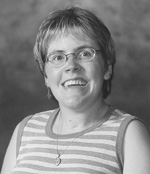
There are many advantages for being selected into the DO-IT program, but I'm only going to mention one of them. After staying at the UW for Phase II of the Summer Study program, I had the great honor of being recommended by DO-IT staff to attend the 1999 National Leadership Conference for Youth with Disabilities. The Mitsubishi Corporation sponsored my participation. The following year I applied to be on the executive board to help plan the 2000 conference. This is a rigorous five-day conference that takes place in June each year, with participants from all over the United States and its territories. Each participant has a disability, some invisible and some visible.
The schedule is exhausting, but the activities are informative and proactive. Every day, an important person in the disability movement who has a disability gives a powerful keynote speech. Each speech gets you deeper and deeper into the disability movement and makes you want to join. For a short time during one day, exhibitors' tables are set up, displaying flyers. Organizations in the disability movement are represented here.
On the first full day of the conference, everyone participated in leadership training. There were about 120 people, including the planning committee, so we had to break up into three smaller groups, all on the same floor. Participants chose what room they started in and then, when that session finished, they moved to another room. It was great training to help us build our leadership goals and skills.
In order to be chosen for the event, you have to fill out an application and write a good essay. You must be 18-25 years old by the time the conference starts. Over 500 applications are received each year. If you decide to apply, good luck and I hope to see you in the leadership community soon! You can get more information by visiting the Web site at http://www.cessi.net/contracts/dps/ncd_nlcyd.html.
Show and Tell - How DO-IT Does It
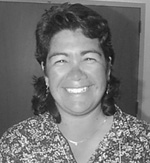
DO-IT Show and Tell is an exciting disability awareness program for Seattle and Spokane School District first grade students. It expands on the practices of traditional show and tell activities and also offers a valuable work experience to the college students who are blind who serve as presenters. The project helps children develop positive attitudes and perceptions of people with disabilities, develop problem-solving skills, and experience how people with disabilities use computers and perform day-to-day tasks. The quotations included in this article are taken from thank you notes sent by the students to DO-IT Show and Tell presenters, following their visits.
DO-IT Show and Tell presentations include a combination of question/answer opportunities, story-time, Braille writing demonstration, and a cane mobility activity. After an initial discussion about blindness, students may be asked to problem solve a variety of situations described by the presenter: How do you think I picked out the clothes I am wearing? How do you think I traveled here today? How can I do my grocery shopping? How can I use my computer? There are also questions the students are anxious to ask: How do you know when to wake up in the morning? Does it hurt to be blind? How can you watch TV? How do you know that the bathtub is full? Presenters use these inquiries to describe a life that is active and accomplished despite the presence of their disability.
"I never thought I could learn so much about blind people."
"I learned blind people can get jobs."
"I learned that you can live by yourself."
First grade students spend a great amount of time developing reading and writing skills, so reading and writing Braille is viewed with admiration and wonder. Classroom teachers provide a list of the students' names, so the presenter can arrive with each child's name Brailled onto an index card. Waiting to be called forward to receive a card with his name represented by the mysterious dots is an exciting time for each participant!
"I really liked how you explained Braille."
"Thank you for coming in our class and sharing Braille."
"I like you. I like how the machine works. I think you are cool."
"Thank you for the card with our names on them. When I took it home my mom was happy."
"Miss Nelson is Missing" and the "Cat in the Hat" are two story options used in a demonstration of reading by Braille. One presenter has also used the oral tradition of storytelling to show how much she relies on her memory, and challenges the students to use their imagination to picture the scenes of the poem that she weaves with words. Many visits wrap up with a chance for the students to try maneuvering through the maze of desks in their classroom with a child-size cane. The students take the challenge quite seriously; eyes are squeezed tightly shut as they carefully swing the cane back and forth in front of them.
"I learned that some people have a guide dog and some have a walking stick."
"Being able to use the cane was fun!"
DO-IT Show and Tell offers a tremendous experience for the first grade students to expand their understanding of the challenges and abilities of people with disabilities. In addition, it helps Show and Tell presenters develop skills in public speaking, teaching, and managing a classroom. They also experience the admiration of their young audience!
"I'll bet you'll be a famous blind person."
"Do you want to be my friend?"
"I am proud of you. Will you come back?"
"I wish you were my teacher."
"I like you and nobody is going to stop me!"
DO-IT Profiles
Here's your chance to learn more about the participants in DO-IT.
DO-IT Scholar Profile
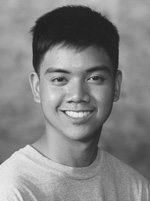
by Jeffrey
My name is Jeffrey. I'm a senior at Tyee High School where I am second-year President of the Tyee Sign Language Club and second-year co-editor of the deaf and hard-of-hearing newsletter. My favorite hobbies are basketball, skiing, and bowling. I have also been in the deaf youth drama program for five years. This program helps me improve my facial expressions and the quality of my communication with others. This year, I played Fred in the comedy, "I Deaf Lucy." I will attend the Rochester Institute of Technology this August. I am very interested in studying computer engineering technology. I would like to learn computer languages such as HTML, Visual, and other programs.
DO-IT Ambassador Profile
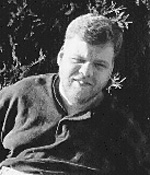
by Anthony
Hello, I'm Anthony from Grand Forks, North Dakota. I was in the DO-IT Scholars program the second year of the actual program (back in the dinosaur age I sometimes say jokingly). I have Cerebral Palsy. I like to explain my whole life as a computer system with lots of different parts all wired together to make something great. To me, DO-IT is like a computer chip inside me. Who I am and what I do today are partially because of DO-IT. I'm twenty-three years old and already have my dream job working at the Prentke Romich Company (PRC), where we build and support communication devices with voice output for people with severe speech disabilities, such as my own. I work in the technical service department answering phone calls at night time and weekends, when PRC is usually closed. I also help them with promoting and selling devices at conferences because, we have found, who better to talk about the benefits of communication devices and assistive technology than somebody who actually uses it every day of his life.
When I'm not on PRC time, I'm usually offering families the assistive technology support they need in order to make sure their child with a disability has a great life. I do all I can to see that their goals and dreams are reached in life. I still have lots of dreams of my own. One of these dreams is to someday see another FDR in a wheelchair run for president using today's assistive technology to help him do his job. Who knows, it might be somebody in DO-IT. All I ask is if you make it, please remember that we love to party and we want to party with you in Washington DC the night you take office!
DO-IT Careers Profile
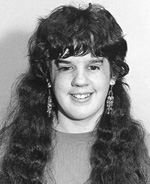
by Anna
I do not know how many times I have felt a crystal bell or a wonderfully textured piece of clothing, and called in excitement to my mother, "Mom, come here. You have to feel this!" only to have her reply, "Yes Anna, I can see it." The implication here to me is that sight is a superior or all-inclusive sense. This automatically decreases the other senses to a level of lesser importance. Yet, I remain convinced that seeing a texture and feeling a texture are not the same, just as seeing a cube and feeling a cube are not equivalent experiences.
When I was in my high school biology class, we watched a film about the senses or sight or some such thing, and I remember the narrator stating that people receive 97% of their input through vision. I was astounded! If this was true, how could I function at all without sight? As it is, I do far more than merely function; I live. I walk to the store, ride the bus, and cook food. I play with my dogs, read books, listen to music, and spend time with friends. I draw, write, and study a martial art. If vision is such a predominant sense, how can I do all of these things and more?
Some time after the film in biology, a teacher explained to me that sighted people take in such a large amount of information through their eyes, that they tend to tune out information received through the other senses. This does not mean, however, that each sense does not have something special to offer. I enjoy listening to the bubble or roar of fountains, but I cannot hear the light reflecting off the water. I love the feel of wading through piles of dry leaves during the fall, but I cannot touch the variety of colors that the leaves turn while still on the trees. Just as sight cannot tell other people everything about the world they live in, touch and sound cannot tell me everything. The difference is that I have to pay more attention to my other senses because I cannot rely on vision. As I often tell people who ask me if I have superior hearing because I am blind, it is not that I hear better than sighted people, but that I am more aware of what I do hear out of necessity.
This year I began doing presentations for DO-IT's Show and Tell program (see related article). I have tried to encourage the children to think about their other senses. I do not want them to grow up thinking that their senses are redundant, but that each sense has something unique to offer. I ask them if they can think of ways to tell an apple and banana apart by touch, and suggest that they ask their parents to let them feel different kinds of produce at the grocery store. I talk to them about how I use my feet to feel different textures on the ground; how I hold a hand above a burner to feel whether it is on or not by the heat; and about how I use my hearing to watch television, detect oncoming cars, cross streets, and distinguish between different people's voices. I try to impress upon them the idea that all of the senses can be used to help us understand and negotiate the world in which we live. By encouraging children to use all of their senses, I am giving them the tools to remain in contact with their environment. By introducing them to all of their senses, I am introducing them to a multilayered universe in which seeing a texture and feeling a texture can be blended into a richer experience.
DO-IT Mentor Profile
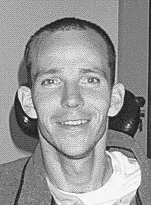
by Greg Smith
I have been involved with the DO-IT program as a mentor for about 5 years. I grew up mostly overseas (five years in Germany and six years in Japan) because my dad was in the U.S. Foreign Service, but now Seattle (or at least the Eastside) is my home. I am a C-5 quad (injured playing football my sophomore year at Stanford University in California).
I got my bachelor's and master's degrees in computer science and have been working as a programmer (or 'Software Design Engineer' as they like to call it) for Microsoft for about 6 1/2 years. I use a headset mouse, but other than that I have required remarkably little in the way of accommodation to allow me to work at the same level as the other programmers here. I think it is a good illustration that the software industry can be an excellent fit for people with disabilities. Up until recently I had been working on Microsoft's Data Access Components for Windows and Office (more info at learn.microsoft.com/en-us/previous-versions/ms810805(v=msdn.10)?redirectedfrom=MSDN). But I decided I needed a change from the product groups, and so, this past September, I took a totally different job with Microsoft Research (research.microsoft.com). I now work in the Computer Vision group, trying to get computers to "see" their surroundings and working on the smart home of the future-it is really great fun. We have a "laboratory" set up like a living room, with cameras that try to keep track of who is in the room and what they might want to do so the computers can help do those things automatically.
The other big news in my life is that during my recent vacation to Las Vegas for my birthday I got engaged! Janna, my fiancée, is graduating from medical school this year and hopefully will be a doctor in residency at the University of Washington this fall. Obviously, it has been a very busy few months...I hope to meet more of you online-I'm looking forward to hearing from you!
Parent-to-Parent
Hello other parents out there,
My name is Elaine, and I live in Chagrin Falls, Ohio (east of Cleveland). My daughter Laura participated in DO-IT in the summer of '97. She then attended the second, shorter program the following summer. The next summer (1999, following her HS graduation) she returned as an intern. Laura is now a sophomore at Hendrix College in Conway, Arkansas. I think it's safe to say she is the only graduate of Solon High School ever to go to Arkansas for college, but she wanted to avoid the ice and snow and cold that are a feature of life here in the north.
Laura's disability is paraplegia/paraparesis. She has incomplete spinal nerve damage from about T-4/5 on down. This was an ischemic injury caused during heart surgery, when circulation to her spinal column was not maintained. Her congenital heart defect has been repaired, and other than regular (lifelong) visits to the cardiologist, she does not have problems. However, she does have some other minor birth defects and chronic illness issues (several autoimmune disorders and immune system problems). Chronic fatigue is part of the picture, and she continues to work with her doctors to manage this.
Laura can walk but uses a wheelchair part of the time. While at DO-IT she teamed up with another participant who pushed her chair-her friend, Keaton, who is blind. This sounds like bad planning, but she insists that they had fewer wrecks than any other pair. I have never met Keaton, but he is obviously a good sport.
I would have to say that DO-IT was very helpful in terms of building Laura's confidence about attending college. She is a very strong student, but managing the day-to-day stuff can be daunting. The major advantage DO-IT gave her was being around other teens with disabilities. The open talk and support were wonderful for her. She has no peers in our community who face the same challenges. The other student in her school who was disabled also had lots of learning problems; while they were acquaintances, they were not able to relate on a lot of levels.
Laura is about to have her 20th birthday. What a thrill this is! Only other parents who have traveled this path will understand my feelings. I think it's more than just pride and joy, it's triumph.
Tech Tips: Cookies and Privacy
Most people who browse the Web don't realize that they're giving information to companies every time they visit a site that uses cookies.
A cookie in the Web sense is a small file that gets transferred to your computer when you visit a site. Cookies were initially designed as a method of having user data persist from one visit to another, or to pass shopping information between one Web server and another. Many commercial sites use multiple Web servers to handle both content (the stuff you view) and purchasing (the check-out process if you buy something). Some content sites track your preferences from one session to another, allowing for a more personalized visit to their site.
Despite assurances to the contrary, there is increasing evidence that blind acceptance of using cookies while Web browsing threatens our privacy. As more and more companies begin to view the data gathered from individuals as their "right," it's clear that we need to decide just how much information about ourselves we wish to make available, and whether to take active steps to thwart this type of personal tracking.
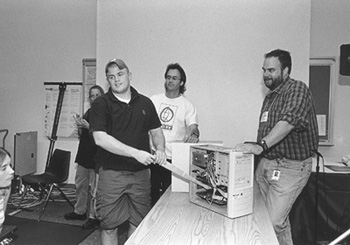
Some of the information we're given about cookies might lead us to believe that they're a benign tool used to enhance our Web experience. Certainly that can be true in some instances, but some companies are taking additional steps that some may find startling. Microsoft's claim that "a site cannot determine your e-mail address unless you send it to the site, as by submitting it in a Web form" is misleading, if not downright false. If you are using a standard browser and default security settings, it's quite simple for a site to gather quite a lot of information about you, including your geographic location and name. If you've provided your e-mail address to a Web site, that can be matched with your cookie information with little difficulty. Matching this information with the unique ID stored in a cookie file is a trivial process. Don't believe me? Check out www.Privacy.net/analyze for a quick demo. The cookie demonstration on this page will allow you to understand how cookies work. www.vortex.com/privacy/priv.09.06 includes additional information about cookies. Though the tone of this article is a bit strident, it does lay out some alarming concepts, not the least of which is that browsing habits can be tied to actual names and household information.
Because I am reluctant to let my personal information into the hands of marketers, I browse from work and home with cookies disabled. The only time I need to turn cookies on is when I wish to purchase something or access some other secure site. Once I'm finished, I disable cookies again, and go on my merry way. Once or twice a week, I empty the cookies from my cookies folder by deleting them manually. Below are some examples of, cookie locations:
- For MS Windows and Internet Explorer 5, cookies are in C:\Windows\Temporary Internet Files and C:WINDOWS\Cookies\. You won't be able to delete the index.dat while in Windows but that's OK. Make sure to remove the copies from both locations.
- In MS Windows and Netscape Communicator, cookies are in C:\Program Files\Netscape\Users\yourusername in the cookies.txt file. You should be able to delete the file with no problem.
- For Macintosh and Netscape (4.x), cookies are in System Folder->Preferences->Netscape Users->yourusername->MagicCookie
- For Macintosh and IE, from the Edit->Preferences folder, under "Receiving Files," click on "Cookies." You can delete or change your cookie preferences here.
I encourage all Web users to be cautious about revealing personal information, even unwittingly through the use of cookies. The benefits of cookie technology are currently outweighed by the potential for abuse.
DO-IT Rocks!
On February 28, 2001 a 6.8 magnitude earthquake hit the Pacific Northwest. DO-IT staff were in a meeting talking about DO-IT activities when the earth began to shake beneath our feet. Following the "drop, cover, hold" (in other words, crawl under a table or desk and hold on to a leg so that it doesn't dance away from you) instructions that we Seattlites have learned from early childhood, we dove under the conference table. Below are accounts of the experiences of DO-IT Scholars, Ambassadors, friends, and staff in our area, as shared (of course) over the Internet:
DO-IT staff: "We are doing remarkably well in Seattle. I visited my son's school and the kids were mainly excited about it...the kids have many earthquake drills around here so everyone knew exactly what to do! The adults were little more nervous."
DO-IT friend: "I hope that the damage was minimal and everyone is ok. I am glad that the students learn the drills and have adapted well. Was there much damage? I hope there were no injuries."
DO-IT Scholar: "Oh the earth moved all right!"
Scholar: "Hi, We felt the quake at 10:55 at school and the school was totally shaking and the portables were swaying; it was freaky. No one knew what happened, but we soon found out. Those after shocks were amazing, all the way over here in Spokane, WA. Wow. We've had lock down drills, fire drills and now, after the fact, we need to do earthquake drills; it was freaky. The last time my family felt one was the day my twin sister and I were born on Oct. 22, 1983."
DO-IT Ambassador: "I am glad to hear everyone is ok. I had not heard about the earthquake till I logged on today. Is anyone having accessibility problems due to the quake?"
Scholar: "Hi everybody. I'm very glad that you all are ok. Today was very scary day. When the earthquake happen I was at school in my math class at the second floor. Suddenly my chair shook and I looked at my teacher, and than we all went under the tables and the floor kept swinging like a swing for about 20 seconds. I got little bit dizzy, but than thanks to God, we all got out of it ok. Before all this happened I went to another school that morning and I gave a presentation there; Kathy came there, too."
Ambassador: "I felt it over here in eastern Washington while I was taking an intelligence battery. It felt similar to being on a bus that was hit by a gust of wind. I felt like I was moving. Pretty weird. I hope all is well in Seattle."
Ambassador: "Hello all!! I hope that everyone in the Washington and Oregon area is safe despite of this powerful earthquake. It would have been a little funny for the DO-IT program to experience this earthquake in the summer during the camp. It would be a first time experience for those who have never been in an earthquake."
Scholar: "Does DO-IT have anybody living in the epicenter?"
Ambassador: "Yes, there are several DO-IT people who live in Lacey. It really didn't seem that bad to me, but then my work building is only 11 years old and it exceeded specs by far. We lost some ceiling tiles, but nothing critical. Best wishes in recovery."
Ambassador: "I live in Graham, which is about 15 miles or so from the epicenter. I was just waking up as it happened, but it didn't seem that bad compared to other quakes I've been in that were less in magnitude. I think the Puget Sound was very lucky with this one."
Ambassador: "Despite it being 7.0 and making a hell of a lot of noise, most of Seattle is quite okay. Yay for engineering. Of course, here in Colorado Springs I was well away from the action."
Ambassador: "I felt the earthquake [in Oregon], but no damage was done as near as I can see."
As The Web Turns: The Frog
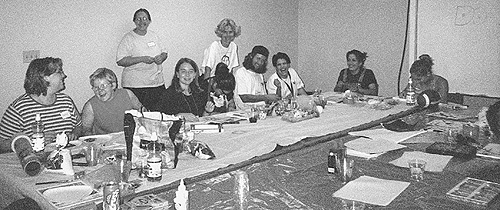
A man was crossing a road one day when a frog called out to him and said, "If you kiss me, I'll turn into a beautiful princess." He bent over, picked up the frog, and put it in his pocket.
The frog spoke up again and said, "If you kiss me and turn me back into a beautiful princess, I will tell everyone how smart and brave you are and how you are my hero." The man took the frog out of his pocket, smiled at it, and returned it to his pocket.
The frog spoke up again and said, "If you kiss me and turn me back into a beautiful princess, I will be your loving companion for an entire week." The man took the frog out of his pocket, smiled at it, and put it back into his pocket.
The frog then cried out, "If you kiss me and turn me back into a princess, I'll stay with you for a year and do ANYTHING you want." Again the man took the frog out, smiled at it, and put it back into his pocket.
Finally, the frog asked, "What is the matter? I've told you I'm a beautiful princess, that I'll stay with you for a year and do anything you want. Why won't you kiss me?"
The man said, "Look, I'm a computer programmer. I don't have time for a girlfriend, but a talking frog is cool."
New E-zine
Hello,
I am writing to tell you about a zine written by teens with disabilities for teens with disabilities. "Disability Central" was awarded a grant from the U.S. Dept. of Education to hire teens and help them start this zine. Our first issue was published in October, 2000. We are also setting up a chat room and a message board for the teens. Each writer for the zine will spend two hours a month in the chat room hosting a forum on his/her ezine topic. We will also be accepting articles from contributing teen writers. The URL for our publication, @CTIVE TEEN Beyond All Barriers, is www.disabilitycentral.com and my email is DocStein@aol.com.
The Browser: Our Calendar of Events
CEC (Council for Exceptional Children)
April 18-21, 2001
Kansas City, MO
Conference concerning special education
exceptionalchildren.org/
AOTA (American Occupational Therapy Association)
April 19-22, 2001
Philadelphia, PA
"Occupational Therapy: Skills for the Job of Living"
301-652-2682
www.aota.org
Keeping the Touch in Technology 2001
April 22-24, 2001
Baton Rouge, LA
"Transforming Learning: A Virtual Reality?
225-578-6325
Touch the Future Expo 2001
April 25-26, 2001
Assistive technology conference
404-657-3083
rebeccaroper@mindspring.com
13th Annual Postsecondary LD Training Institute (CPED - Center on Postsecondary Education and Disability)
June 5-9, 2001
Portland, ME
Assist concerned professionals to meet the unique needs of college students with learning disabilities and other hidden disabilities.
860-486-0208
cped.uconn.edu/
Symposium Series on Assistive Technology
June 18-22, 2001
Chicago, IL
Advanced workshops on specialized topics of AT.
818-677-2578
NECC (National Education Computing Conference)
June 25-27, 2001
Chicago, IL
Exploring the opportunities and innovations of education in the 21st century.
www.neccsite.org
AHEAD (Association on Higher Education and Disability)
July 24-28, 2001
Portland, OR
"Widening the Umbrella: Access for Everyone, Everywhere"
617-287-3880
carol.desourza@umb.edu
17th Annual Conference on Distance Teaching and Learning
August 8-10, 2001
Madison, WI
608-265-4159
distel@education.wisc.edu
https://dtlconference.wisc.edu/
The Second International Conference for Parents with Disabilities and Their Families
October 11-14, 2001
Oakland, CA
Hosted by Through the Looking Glass-the National Resource Center for Parents with Disabilities
510-848-1112 ext. 110
lookingglass.org/
Closing the Gap
October 16-17, 2001-Preconference
October 18-20, 2001-19th Annual Conference Minneapolis, MN
Computer Technology in Special Education and Rehabilitation
517-248-3294
www.closingthegap.com
Fifth Annual Collaborative Conference: Achieving New Heights with Assistive Technology, A Rocky Mountain Regional Collaboration
November 1-3, 2001
Denver, CO
303-315-1280
maureen.melonis@uchsc.edu
ASAAW (VSA arts of Washington)
October 20, 2002
Seattle, WA
Open competition for artists with disabilities to share their talents in a Northwest traveling exhibition.
bartok.vsarts.org/washington
How can you DO-IT?
- Sign up to receive DO-IT NEWS if this newsletter was not mailed directly to you.
- Volunteer as a Mentor or to help with one of our Summer Study programs.
- Pass this newsletter on to someone you know who can benefit from our programs.
- Donate money to support and extend DO-IT activities including sponsoring Scholars from states outside of Washington, special events, work-based learning experiences, participant attendant or travel costs, refreshments for program participants, and creation and distribution of educational videotapes and publications.
DO-IT today by completing the form below! You may also make a secure online credit card donation at the University of Washington Make a Gift page by selecting the "DO-IT Program Gift Fund" option.
___ Sign me up to receive copies of DO-IT NEWS, a free program newsletter.
___ Send me more information about DO-IT volunteer opportunities.
___ I would like to make a donation (payable to the University of Washington, Federal ID#91-6001537) to support DO-IT operations.
___ I have enclosed a check for $____________
___ Please charge $____________ to my credit card.
___ VISA ___ Mastercard
Date _____________
Card Number __________________________ Expiration Date _____________
Card Holder Name ___________________________________________________
Signature _____________________________________________________
Address ____________________________________________________________
City __________________________ State _____________ Zip ____________
Phone: Home __________________________ Business ____________________
E-mail: ____________________________________________________________
Your gift is tax-deductible as specified in IRS regulations. Pursuant to RCW 19.09, the University of Washington is registered as a charitable organization with the Secretary of State, State of Washington. For more information, call the Office of the Secretary of State, 1-800-322-4483.
Mail to:
DO-IT
University of Washington
Box 354842
Seattle, WA 98195-4842
Thank you!
More About DO-IT
DO-IT NEWS is published at the University of Washington with input from DO-IT staff, Pals, Scholars, Ambassadors, and Mentors. DO-IT is primarily funded by the National Science Foundation, the U.S. Department of Education, and the State of Washington.
Executive Editor: Sheryl Burgstahler
Managing Editors: Nanette Rosenthal, Amy Schieffer
DO-IT (Disabilities, Opportunities, Internetworking, and Technology) serves to increase the successful participation of individuals with disabilities in challenging academic programs such as those in science, engineering, mathematics, and technology. Primary funding for DO-IT is provided by the National Science Foundation, the State of Washington, and the U.S. Department of Education. DO-IT is a collaboration of UW Information Technology and the Colleges of Engineering and Education at the University of Washington.
Grants and gifts fund DO-IT publications, videos, and programs to support the academic and career success of people with disabilities. Contribute today by sending a check to DO-IT, Box 354842, University of Washington, Seattle, WA 98195-4842.
Your gift is tax deductible as specified in IRS regulations. Pursuant to RCW 19.09, the University of Washington is registered as a charitable organization with the Secretary of State, state of Washington. For more information call the Office of the Secretary of State, 1-800-322-4483.
To order free publications or newsletters use the DO-IT Publications Order Form; to order videos and training materials use the Videos, Books and Comprehensive Training Materials Order Form.
For further information, to be placed on the DO-IT mailing list, request materials in an alternate format, or to make comments or suggestions about DO-IT publications or web pages contact:
DO-IT
University of Washington
Box 354842
Seattle, WA 98195-4842
doit@uw.edu
www.uw.edu/doit
206-685-DOIT (3648) (voice/TTY)
888-972-DOIT (3648) (voice/TTY)
206-221-4171 (fax)
509-328-9331 (voice/TTY) Spokane
Founder and Director: Sheryl Burgstahler, Ph.D.